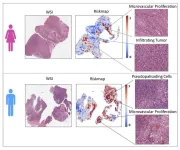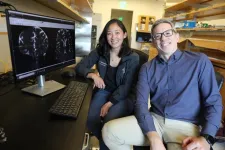(Press-News.org) Lower-income adults with Medicare Advantage plans are more likely to have difficulty paying for dental, vision, and hearing services than higher-income beneficiaries—despite enrolling in plans that cover these benefits, according to a new study published in Health Affairs.
Medicare Advantage plans offer a private insurance alternative to traditional Medicare coverage for health insurance. The most common supplemental benefits are dental, vision, and hearing, with more than 90 percent of Medicare Advantage plans providing coverage for one or more. These supplemental benefits, which are not available through traditional Medicare, are largely funded by rebate dollars paid by the Centers for Medicare and Medicaid Services (CMS) to the private insurers.
“The high need for dental, vision, and hearing care among Medicare recipients drives the high demand for supplemental benefits,” said Avni Gupta, a health policy researcher who recently earned her PhD in health policy and management from the NYU School of Global Public Health and is now at the Commonwealth Fund. “However, these added benefits are expensive for Medicare, which pays nearly $20 billion a year in rebates to Medicare Advantage insurers for supplemental benefits.”
An increasing number of low-income older adults are enrolling Medicare Advantage plans over traditional Medicare plans—a shift that may be driven by the supplemental benefits available in these plans. However, supplemental benefits may not provide full financial protection, as beneficiaries still face relatively high out-of-pocket costs and forego needed dental, vision, and hearing care.
To understand whether coverage for supplemental benefits through Medicare Advantage is meeting the needs of those enrolled, the researchers analyzed nationally representative data from a 2018-19 survey of Medicare Advantage beneficiaries. They analyzed differences by income and the plans’ star ratings, a measure of quality.
The researchers found that lower-income Medicare Advantage beneficiaries are more likely to experience cost-related barriers in accessing dental, vision, and hearing services than higher-income beneficiaries, even after adjusting for several measures of benefit generosity. Overall, nearly 11 percent of beneficiaries reported unmet dental need, 4 percent reported unmet vision need, and 2 percent reported unmet hearing need because of cost.
The researchers also found that enrolling in higher-quality Medicare Advantage plans—those with the highest star ratings—was associated with lower unmet needs for dental services overall and for lower-income groups, meaning that higher star ratings translated to better dental coverage. This was not true for hearing and vision coverage.
However, despite CMS making higher rebate payments to Medicare Advantage plans with high star ratings, the positive impact of star ratings on dental coverage was not found to be driven by these bonus payments.
“This raises questions about whether the higher rebate payments to highly rated Medicare Advantage plans in the form of the quality bonus payments actually improve access to the funded services for beneficiaries,” added Gupta.
The researchers note that CMS should consider measuring and monitoring the coverage, quality, and equity of supplemental benefits in order to make coverage more equitable and better link rebate payments to the value of supplemental benefits for Medicare Advantage enrollees.
“As the popularity of Medicare Advantage plans continues to increase, there is a need for more accountability and better oversight on how rebate dollars are being used to improve equitable access to supplemental benefits covering services we all use and need, such as dental, hearing, and vision care,” said José A. Pagán, a professor and chair of the Department of Public Health Policy and Management at the NYU School of Global Public Health. “Good stewardship in rebate payments means that Medicare Advantage beneficiaries should get the highest possible value as a result of financial incentives.”
In addition to Gupta and Pagán, study authors include Diana Silver of the NYU School of Global Public Health, Sherry Glied of NYU’s Robert F. Wagner Graduate School of Public Service, Kenton Johnston of Washington University in St. Louis, and David Meyers of Brown University School of Public Health.
END
Supplemental Medicare benefits still leave dental, vision, and hearing care out of reach for many
A new study finds that lower-income adults with dental, vision, and hearing benefits through Medicare Advantage still face cost-related barriers to care
2024-10-07
ELSE PRESS RELEASES FROM THIS DATE:
UW–Madison researchers use AI to identify sex-specific risks associated with brain tumors
2024-10-07
MADISON — For years, cancer researchers have noticed that more men than women get a lethal form of brain cancer called glioblastoma. They’ve also found that these tumors are often more aggressive in men. But pinpointing the characteristics that might help doctors forecast which tumors are likely to grow more quickly has proven elusive. University of Wisconsin–Madison researchers are turning to artificial intelligence to reveal those risk factors and how they differ between the sexes.
Radiology and biomedical engineering professor Pallavi Tiwari and her colleagues have published ...
George Mason researchers conducting AI exploration for snow water equivalent
2024-10-07
George Mason Researchers Conducting AI Exploration For Snow Water Equivalent Forecasting In Western U.S. With Physics-Informed Neural Network & GeoWeaver
Ziheng Sun, Research Assistant Professor, Center for Spatial Information Science and Systems (CSISS), Geography and Geoinformation Science, College of Science; Mingrui Liu, Assistant Professor, Computer Science, College of Engineering and Computing (CEC); and Keren Zhou, Assistant Professor, Computer Science, CEC, are studying the dynamics of snow water equivalent (SWE).
SWE measures the amount of water available in snow.
The researchers will use ...
Huskisson & Freeman studying gut health of red pandas
2024-10-07
Sarah Huskisson, PhD candidate, Environmental Science and Policy, College of Science, is characterizing the gastrointestinal (GI) health of red pandas using short-chain fatty acid (SCFA) concentrations. Huskisson is advised by Elizabeth Freeman, Associate Professor, School of Integrative Studies. Huskisson is co-Principal Investigator on the project.
Huskisson and Freeman aim to provide the first characterization of SCFA concentrations for red pandas and hope that differences in concentrations can be pinpointed between healthy and mucoid/loose stools.
They have two hypotheses.
First, they hypothesize that ...
Brain’s waste-clearance pathways revealed for the first time
2024-10-07
Scientists have long theorized about a network of pathways in the brain that are believed to clear metabolic proteins that would otherwise build up and potentially lead to Alzheimer’s and other forms of dementia. But they had never definitively revealed this network in people — until now.
A new study involving five patients undergoing brain surgery at Oregon Health & Science University provides imaging of this network of perivascular spaces — fluid-filled structures along arteries and veins — within the brain for the first time.
“Nobody has shown it before now,” said senior author Juan Piantino, ...
Plenty more fish in the sea? Environmental protections account for around 10 percent of fish stocks on coral reefs
2024-10-07
EXPERT AVAILABLE
Embargoed until Tuesday 8 October at 06:00 AEDT
New research from the University of Sydney shows that international conservation efforts account for approximately 10 percent of fish stocks on coral reefs.
The global study, published in Proceedings of the National Academy of Sciences, was led by Professor Joshua Cinner from the School of Geosciences and lead analyst Dr Iain Caldwell from the Wildlife Conservation Society. The international research team also included scientists from US, UK, Kenya, France and Germany among others.
Looking at fish survey data across nearly 2,600 tropical ...
Macaques give birth more easily than women: no maternal mortality at birth
2024-10-07
An international research team led by the University of Vienna and the Medical University of Vienna has used long-term demographic data from Japanese macaques – a monkey species within the family of Old World monkeys – to show that, unlike humans, there is no maternal mortality in these primates linked to childbirth. The results of the study were recently published in the renowned scientific journal PNAS.
The evolution of large brains and associated large fetal heads are key factors linked to maternal mortality in primates during childbirth. For humans, the baby's large head in relation ...
Five George Mason researchers receive funding for Center for Climate Risks Applications
2024-10-07
Five George Mason Researchers Receive Funding For Center For Climate Risks Applications
Luis Ortiz, Assistant Professor, Atmospheric, Oceanic and Earth Sciences (AOES), College of Science; Fengxui Zhang, Assistant Professor, Schar School of Policy and Government; Edward Oughton, Assistant Professor, Geography and Geoinformation Science, College of Science; Natalie Burls, Associate Professor, AOES, and Director, Climate Dynamics Program, College of Science; and James Kinter, Director, Center for Ocean-Land-Atmosphere Studies (COLA); Director, ...
Advancing CRISPR: Lehigh University engineering researchers to develop predictive models for gene editing
2024-10-07
CRISPR is a revolutionary tool that allows scientists to precisely modify the genome and gene expression of cells in any organism. It’s a reagent—a substance that facilitates a reaction—that combines an enzyme with a programmable RNA capable of locating specific genetic sequences. Once guided to the correct spot, the enzyme acts like a pair of scissors, cutting, replacing, or deleting sequences of DNA.
Researchers are now using the technology to, among many things, treat genetic diseases, develop medical therapeutics, and design diagnostic tools.
“CRISPR is very powerful, but it comes with side effects,” says Lehigh University ...
Protecting confidentiality in adolescent patient portals
2024-10-07
Weill Cornell Medicine researchers found that the possibility of parental disclosure through online patient portals led older adolescents to hesitate in sharing complete health information with doctors, putting them at risk of missed diagnoses and treatments. The paper noted that confidentiality concerns were increased among females and those who are sexual and gender minorities.
The results, published Oct. 7 in JAMA Pediatrics, are based on a national online survey that targeted 18 to 26 years olds who ...
Gatling conducting digitization project
2024-10-07
Benjamin Gatling, Associate Professor, English, College of Humanities and Social Sciences (CHSS), is set to receive funding for a project in which he will digitize a significant portion of the archive of the Folklore Fund at the Rudaki Institute of Language and Literature in Dushanbe, Tajikistan.
Gatling aims to train local archive staff in best practices, the preservation of materials, and digitization and metadata creation for the majority of the archive’s holdings, as well as the curation of digitized materials.
The archive’s holdings include bound notebooks, notecards, ...
LAST 30 PRESS RELEASES:
Many mothers in Norway do not show up for postnatal check-ups
Researchers want to find out why quick clay is so unstable
Superradiant spins show teamwork at the quantum scale
Cleveland Clinic Research links tumor bacteria to immunotherapy resistance in head and neck cancer
First Editorial of 2026: Resisting AI slop
Joint ground- and space-based observations reveal Saturn-mass rogue planet
Inheritable genetic variant offers protection against blood cancer risk and progression
Pigs settled Pacific islands alongside early human voyagers
A Coral reef’s daily pulse reshapes microbes in surrounding waters
EAST Tokamak experiments exceed plasma density limit, offering new approach to fusion ignition
Groundbreaking discovery reveals Africa’s oldest cremation pyre and complex ritual practices
First breathing ‘lung-on-chip’ developed using genetically identical cells
How people moved pigs across the Pacific
Interaction of climate change and human activity and its impact on plant diversity in Qinghai-Tibet plateau
From addressing uncertainty to national strategy: an interpretation of Professor Lim Siong Guan’s views
Clinical trials on AI language model use in digestive healthcare
Scientists improve robotic visual–inertial trajectory localization accuracy using cross-modal interaction and selection techniques
Correlation between cancer cachexia and immune-related adverse events in HCC
Human adipose tissue: a new source for functional organoids
Metro lines double as freight highways during off-peak hours, Beijing study shows
Biomedical functions and applications of nanomaterials in tumor diagnosis and treatment: perspectives from ophthalmic oncology
3D imaging unveils how passivation improves perovskite solar cell performance
Enriching framework Al sites in 8-membered rings of Cu-SSZ-39 zeolite to enhance low-temperature ammonia selective catalytic reduction performance
AI-powered RNA drug development: a new frontier in therapeutics
Decoupling the HOR enhancement on PtRu: Dynamically matching interfacial water to reaction coordinates
Sulfur isn’t poisonous when it synergistically acts with phosphine in olefins hydroformylation
URI researchers uncover molecular mechanisms behind speciation in corals
Chitin based carbon aerogel offers a cleaner way to store thermal energy
Tracing hidden sources of nitrate pollution in rapidly changing rural urban landscapes
Viruses on plastic pollution may quietly accelerate the spread of antibiotic resistance
[Press-News.org] Supplemental Medicare benefits still leave dental, vision, and hearing care out of reach for manyA new study finds that lower-income adults with dental, vision, and hearing benefits through Medicare Advantage still face cost-related barriers to care




